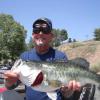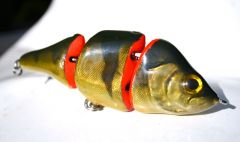-
Posts
14,654 -
Joined
-
Last visited
-
Days Won
356
Content Type
Profiles
Articles
TU Classifieds
Glossary
Website Links
Forums
Gallery
Store
Everything posted by mark poulson
-
MT, I have friends who fish the salt who catch barracuda and calicos with them, so I can't see why they wouldn't work for pike. You may need to upgrade the snap, since pike get big. EWG, Thanks. That's where I got mine, but it was a couple of years ago. I hadn't seen that rounded shape before.
-
I thnk they look great! Where did you get your blades?
-
rofish, I thnk you, Dieter, and Luretreker should form your own lure company, Frankenstein Lures. Each lure could be named for some monster. The newest design you just posted should be call, "Nessie", for the Loch Ness Monster. You guys are the best.
-
YOU DA MAN!!!!!!
-
The only lures that I've repainted that were at all affected were some small plastic suspending jerk baits. They are now slow sink.
-
I had one of the new artificial wine corks, so I took it, sanded it into a popper shape, cupped the face and put a through wire from front to back. It floats great, and hangs perfect without ballast. Totally waterproof. I was just goofing off, so it's not pretty, but I'm going to play around with priming and painting tomorrow. It's a soft matl., so I'll probably topcoat it with Nu Luster 55, which is a more flexible topcoat than D2T. If it were a hard plastic, D2T would be my choice. Right now it just has a tail hook. I'm still debating whether to make another hook hanger with a loop to intercept the long, front to back through wire. Has anyone else tried this stuff yet? I know, I know, it's just another excuse to drink more wine, like I needed one.
-
Castmaster, Thanks. Address sent in a PM. Bill, That looks interesting. Let us know how it works out. I have a couple of coils of sst control line airplane cables, left over from my second son. We used to build and fly model airplanes. I'd played around in my head with the idea of using the cable for a hinge system, but never got farther than that.
-
Or the White Sox. Is this the Cubbies' year?
-
Years ago I made a dragonfly lure with two floating worms. I took the lighter colored one and split it down the middle lengthwise. Then I crossed the two halves in an X and glued them to the top of the second worm. I used a 1/0 offset worm hook and rigged it texposed. It cast horribly, so I used a spinning rod to throw it. But it was deadly in the summer in front of tules. I stopped using it because it was just too hard to cast. Like trying to cast a sail.
-
Good luck. Post some pics when you're ready. We love to see what everyone else is doing.
-
The main advantage with using a larger wire is that it's easier to keep a larger bit from wandering when you're drilling wood. I've used sst spinnerbait wire, sst welding rod, and sst bicycle spokes, and they all work. As soon as I can find the Q tips with the hollow plastic handles, I'm going to try them as sleeves for the pins. The larger hole for the sleeve should make drilling even easier.
-
I just used one of the originals as a guide. The top 1/4 to 1/3 of the blade seems to be where the bend occurs. On the originals, it's a gentle curve. I make more of an angled bend, because my blades, which I got from Barlows, are too stiff to gently bend. I bend it a little at a time with a pair of needle nose pliers, until I get it to swim the way I want it to. Just try to make the bend even, so it swims straight.
-
Palmetto Balsa, You're absolutely right about balancing out your lures on the wheel. I've always done that, and never thought of mentioning it here. If I'm only doing one lure, I put a similar lure that's already finished opposite the new one on the wheel. The things we take for granted that aren't as obvious as we think. Like my step-brother, who is a math professor and computer genius at an eastern Washington university. He owned a restaurant, and built his own wooden bar and bar top. He researched bar top clear coats, and came up with the one that seemed bullet proof. He called the tech support for the product, and discussed prep and mixing and application. The big day came. He mixed it up and spread it, and it looked perfect. He went home, and returned the next day. The product had a 12 hour curing time. He went into the bar, and the top looked perfect. He touched it with his finger, and it was still liquid! He called the tech support, in a panic, and reported his results. They responded, "You didn't let it get contaminated with oxygen, did you?" In all the conversations between this "genius" professor, and the "expert" tech staff, no one had thought to mention that the product was meant to be applied in an oxygen free environment. He then proceeded to scrape off all the high tech stuff, resand the bartop, and apply cheap decopage coating, which is still doing just fine today. Just shows how much "common sense" stuff that's so obvious it doesn't need to be mentioned we take for granted, and how it can return to bite us in the a$$.
-
It's only been a month, but, so far, the lures I've coated with the UV inhibited Nu Lustre 55 haven't yellowed, and I've fished them a lot, and left them on the deck in the sun.
-
My rotisserie motor has a reverse switch that kicks in when the wheel is jammed, or when I turn it off and on. Maybe you just have to bypass that switch, if yours has one.
-
-
Looks great. Nice job. You can use braid, with some super glue, to reinforce the skirt ties. Bending the blade, like the original Radlures Chatterbaits, will let you retrieve it faster without having it rise up to the surface.
-
I think that, if it doesn't say "contains UV inhibiters", it will yellow. Most manuf. have a website or tech. line you can contact to ask this question.
-
Just a couple of thoughts to muddy the water. I find that poppers that sit a little tail down work better. This helps them pop or chug more easily as you retrieve them, since the cupped face is constantly trying to face up. You can achieve this by drilling you tail hook hole over sized, and adding lead there. If you're using a through wire, you'll probably have to experiment with a sacrificial wire, one that you don't mind cutting off and throwing away, to be able to adjust the weight. With screw eyes, just hang enough weight on the tail hook to get the lure to hang down a bit, and then put that weight into the over sized hole. You'll have to re drill for the screw eye, and use one that's long enough to get into the wood again. You can try to add the weight by drilling the lure body next to the screw eye instead, but most poppers are so tapered toward the rear that there's not a lot of room in the wood to drill. If you're using a through wire, you can leave the tail section long enough to wrap lead wire, from a fly tying shop, onto the shaft before the hook attachment eye. You'll probably wind up making a few before you get one that works the way you want it to. So don't invest the time in a great paint job and topcoat until you've tested the lures and got one that works. Been there, done that.
-
Thanks for the tip. I'll ask him for the pulverized Hilite.
-
Thanks for the tip. I have a friend who just got back into pouring, and I'm going to bum some plastic glitter from him.
-
I've handled that problem two different ways. My first method was, after the pin holes are drilled, but before I assembled the lure, to put a drop of runny crazy glue into one side of the pin holes, then turn the lure over and put another drop into the other side. The glue usually ran all the way through the holes from one side, but I did both just to play safe. Then I re drilled the holes using a piece of the same wire that the pins were made from. After the lure was finish painted, I'd pre coat the insides of the joints with D2T, letting it lap onto the face about 1/4" to get an overlap with the face epoxy. Then I'd assemble the lure, push the pins all the way down to their finished position, mount them on my drying wheel, and use Etex to coat the faces. Now I use Minwax Wood Hardener for sealing the whole bait, including the pin holes. It's very runny, and is designed to be drawn into the cells of the wood to strengthen them. I apply it with a Q tip dipped into the can, and it's runny enough that I think it penetrates the same as the crazy glue. I still re drill the pin holes after 24 hrs., and then prime with Krylon white primer and proceed. I topcoat with Nu Lustre 55, UV inhibited, now, but my paint process is the same, and I've not had any cracking or failures. I haven't made any more jointed lures since Snax posted that tip, so I can't comment on whether it works or not, but I plan to try it. I'm thinking I will still have to seal the drill holes before I put in the Q tip liner sleeve, but maybe I can just glue the liner in and that will do it. Or maybe the Wood Hardener would penetrate around the pin holes with the sleeves in place, and that would be it. I look forward to finding out.
-
Are you sure it's your first try???? Those look GREAT!
-
I would put a line tie low in th cupped face, a hook hanger about a third of the way back toward the tail, and another one in the tail. Seal the bait, put on the split rings and hooks, and try it. Ash is a heavy wood, so you may not need any balast, but I suspect you may need a belly weight toward the read to get it to pop well. Only testing will tell you.





